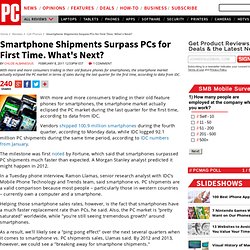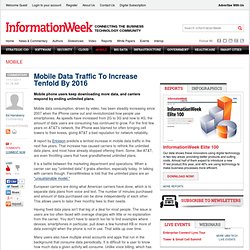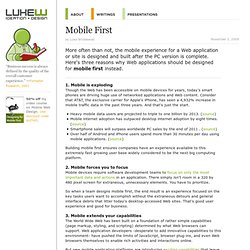

Smartphone Shipments Surpass PCs for First Time. What's Next? With more and more consumers trading in their old feature phones for smartphones, the smartphone market actually eclipsed the PC market during the last quarter for the first time, according to data from IDC.

Vendors shipped 100.9 million smartphones during the fourth quarter, according to Monday data, while IDC logged 92.1 million PC shipments during the same time period, according to IDC numbers from January. The milestone was first noted by Fortune, which said that smartphones surpassed PC shipments much faster than expected. A Morgan Stanley analyst predicted it might happen in 2012. In a Tuesday phone interview, Ramon Llamas, senior research analyst with IDC's Mobile Phone Technology and Trends team, said smartphone vs.
PC shipments are a valid comparison because most people – particularly those in western countries – currently own a computer and a smartphone. As a result, we'll likely see a "ping pong effect" over the next several quarters when it comes to smartphone vs. Mobile Data Traffic To Increase Tenfold By 2016 - mobility Blog. Mobile phone users keep downloading more data, and carriers respond by ending unlimited plans.

Mobile data consumption, driven by video, has been steadily increasing since 2007 when the iPhone came out and revolutionized how people use smartphones. As speeds have increased from 2G to 3G and now to 4G, the amount of data users are consuming has continued to grow. For the first few years on AT&T's network, the iPhone was blamed for often bringing cell towers to their knees, giving AT&T a bad reputation for network reliability. A report by Ericsson predicts a tenfold increase in mobile data traffic in the next five years. That increase has caused carriers to rethink the unlimited data plans, and most have already stopped offering them.
It is a battle between the marketing department and operations. European carriers are doing what American carriers have done, which is to separate data plans from voice and text. World mobile data traffic to explode by factor of 26 by 2015. Anyone who thinks that the Internet revolution is in anything but its early phase had better take a look at Cisco's latest Global Mobile Data Traffic Forecast (PDF).

There are so many startling predictions and observations in the report that we'll just begin with these headlines: There will be 788 million mobile-only Internet users by 2015.Global mobile data traffic will increase by a factor of 26 by 2015.World mobile data grew by a factor of 2.6 in 2010 from 2009. Average smartphone usage doubled: 79 MB per month, up from 35 MB per month in 2009.Android operating system data use is rapidly catching up to the iPhone.In 2010 almost a third of smartphone traffic was offloaded onto fixed networks via dual-mode or Femtocells.Millions of people around the world have cell phones but no electricity, and by 2015 a majority in the Middle East and Southeast Asia will live "off-grid, on-net. " Three times three (almost) Double your pleasure On top of that: Android rising The second is less obvious. Visual Networking Index: Global Mobile Data Traffic Forecast Update, 2010–2015 [Visual Networking Index.
Mobile First. More often than not, the mobile experience for a Web application or site is designed and built after the PC version is complete.

Here's three reasons why Web applications should be designed for mobile first instead. 1. Mobile is exploding Though the Web has been accessible on mobile devices for years, today's smart phones are driving huge use of networked applications and Web content. Consider that AT&T, the exclusive carrier for Apple's iPhone, has seen a 4,932% increase in mobile traffic data in the past three years. Heavy mobile data users are projected to triple to one billion by 2013. Building mobile first ensures companies have an experience available to this extremely fast growing user base widely considered to be the next big computing platform. 2.
Mobile devices require software development teams to focus on only the most important data and actions in an application. Flexible, Mobile-First Layouts with CSS3. Some experts are projecting mobile devices to become the dominant medium for web browsing within five years, overtaking browsing on desktop computers.

Regardless of how accurate this projection turns out to be, it is clear that formatting websites for mobile-friendly viewing needs to become a staple of web design and development. There are many ways to accomplish this, of course. However, CSS3 provides a fairly rich toolset for mobile-friendly formatting, relying on the client's browser capabilities instead of back-end templating. Step 1. Think Ahead There are a few issues that should be thought about before diving right into styling a layout. Mobile Web Browsing First, what should one keep in minds when designing for mobile browsers? Limit HTTP requests: data transfer over 3G can be quite taxing. "The overall point is to know ahead of time what your site is likely to look like in various browsers before seeing it.
" Browser Support (on Desktops) Secondly, keep browser support in mind. Mobile First.